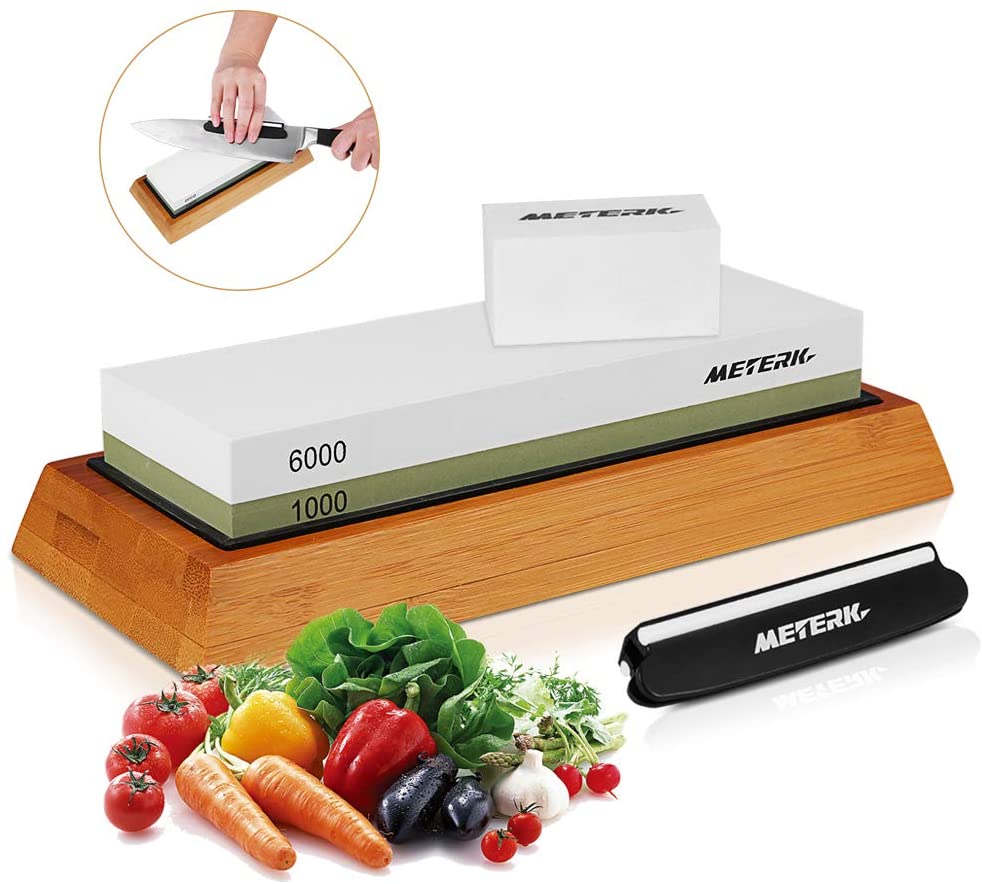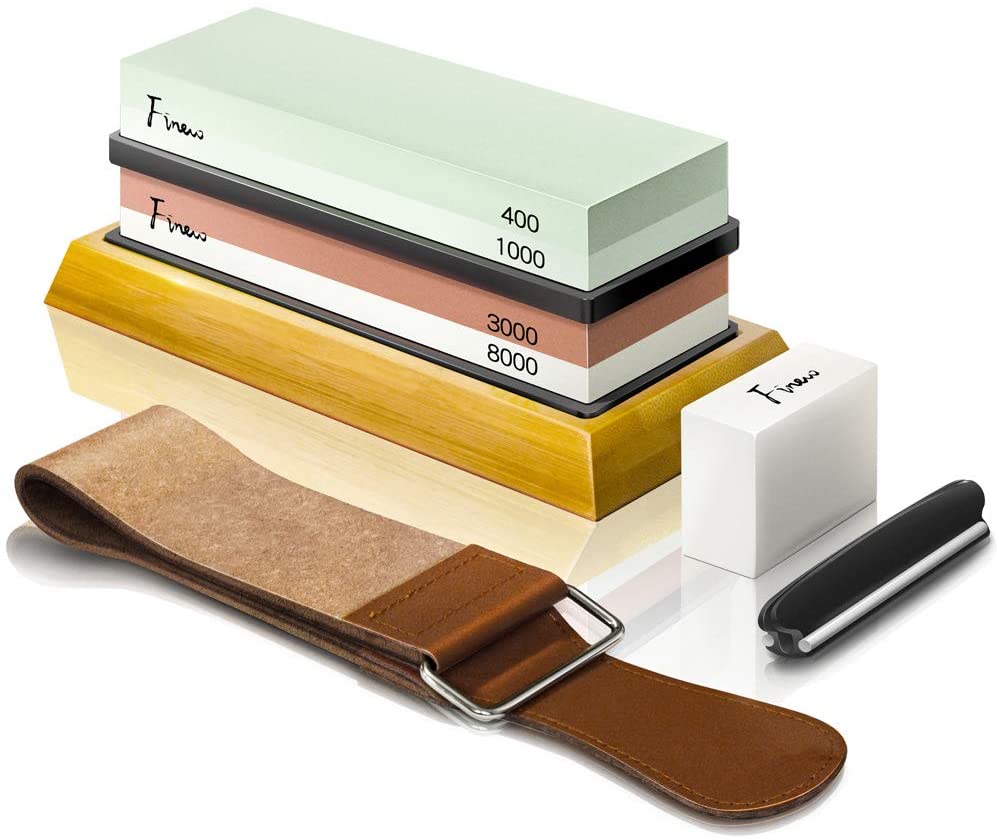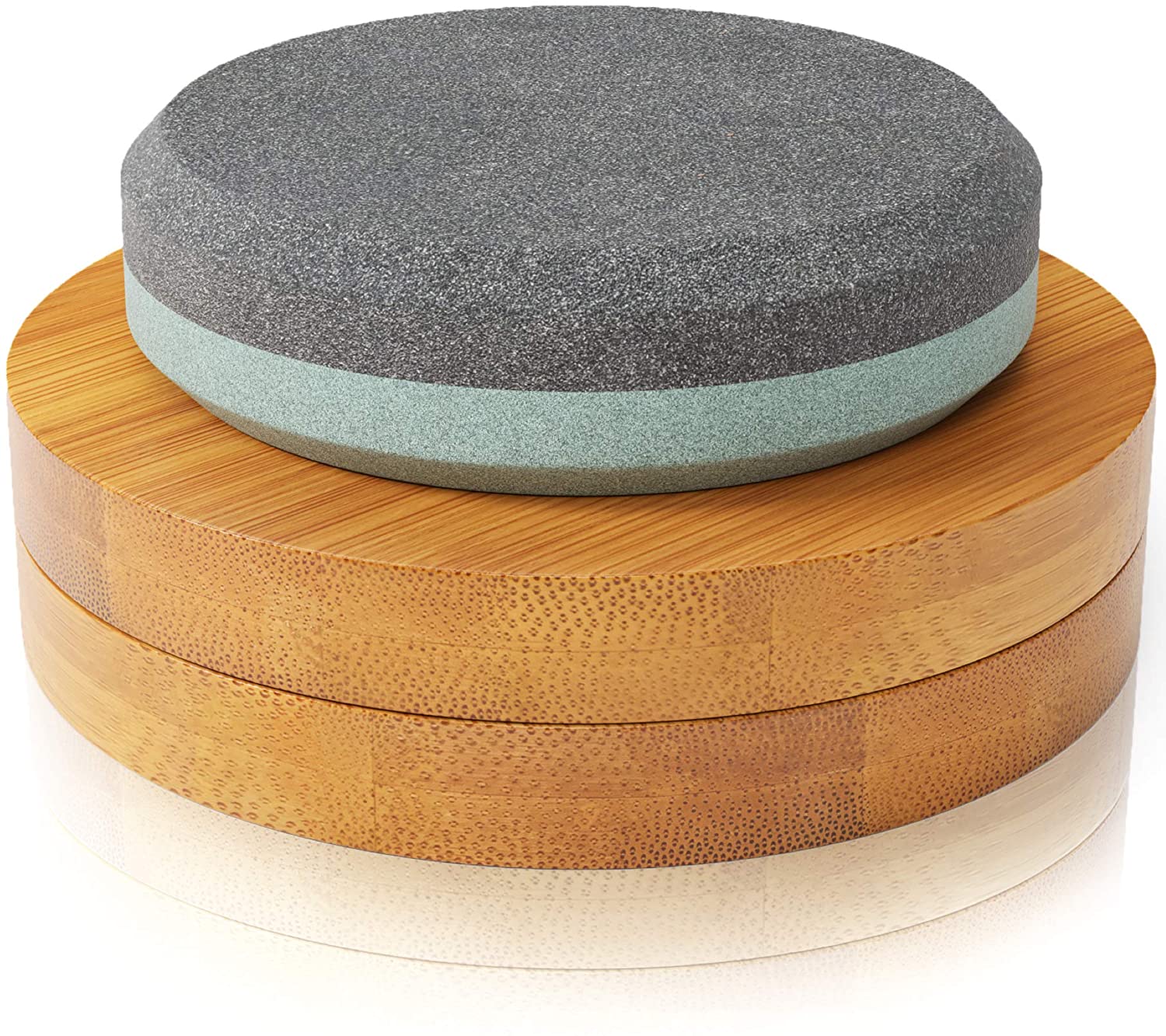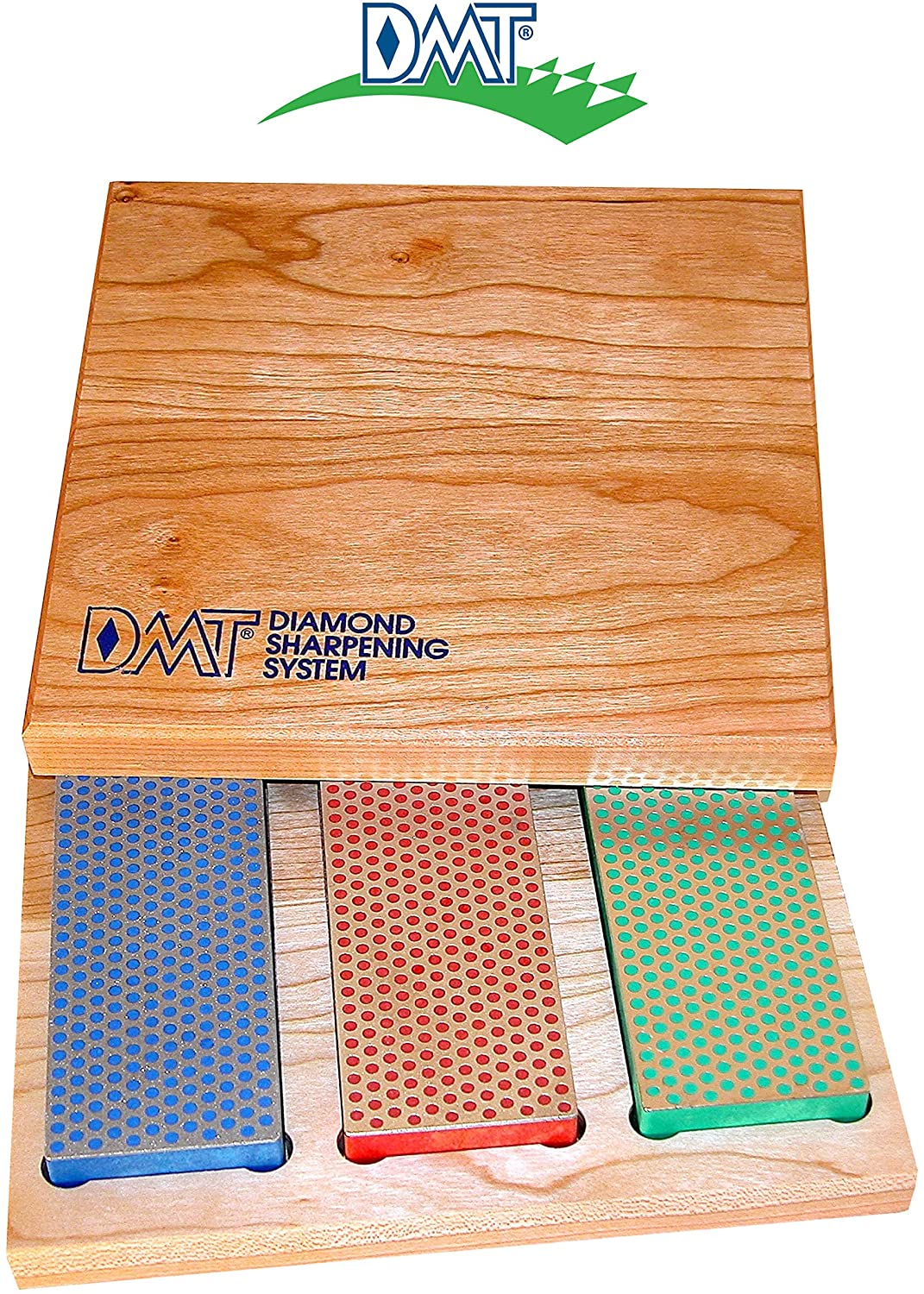Best Sharpening Stone
Savvy chefs and craftsmen know the importance of using the best tools to get the job done right. But they also know that even the best utensil will be useless if it’s not maintained and cared for. Nowhere is this more important than with knives.
A dull blade is the enemy of the person wielding it. Not only will it ruin whatever you’re trying to slice or dice, but by forcing the issue, you can be hurt. That’s where a good sharpening stone comes in. Since the beginning of time we have sharpened our tools on stones, or whetstones, slowly scraping and honing until the blade gleams.
These days, whether you work with knives in the kitchen, scissors in your craft room or an axe in the barn, keeping the blades sharp is easy to do using the right sharpening stone. With different grades for different blades, it takes a bit of research to determine which one is best for your needs.
We feature four sharpening stones you can buy online. Read on to find the one for you.
Top Pick Best For the Kitchen: Meterk Premium Whetstone Sharpening Stone
It’s taken you years to equip your kitchen with all the right knives to slice and dice your way through dozens of dinner parties and family meals. In fact, you’ve spent hours of research making sure you purchase only top-of-the-line knives that you can keep for a lifetime. Now that your kitchen is complete, you are looking for the right sharpening stone to keep your knives in tip-top shape.
This 1000/6000 grit whetstone by Meterk is made from professional grade white corundum that’s highly durable and corrosion and heat resistant. The double-sided 1000 and 6000 grit is all you’ll need to maintain your kitchen knives at their sharpest. Use the white side – 1000 coarse grit – to refine a dull edge, and the green side – the fine 6000 grit – to polish a blade for a mirror-like finish.
This awesome whetstone is suitable for anything you want to sharpen and polish, from kitchen and hunting knives, scissors and razors. And it’s so easy to assemble and use; all you need is water. First soak the sharpening stone in water for about five minutes. Then select the desired angle for the job and begin sharpening. Use the coarse side to grind for about 10 to 15 minutes and then fine grind with the 6000 for about 10 minutes, keeping the stone wet the whole time.
Other features include a convenient silicone base that holds the stone in place on a non-slip bamboo base and an angle guide for sharpening at the correct angle. There’s even a fixing stone to repair the grindstone and keep the surface smooth. What more could you ask for in an easy-to-use, two-sided stone?
Pros:
- Affordable
- Easy to use
- Made from high quality material
- Dual grit combination 1000/6000
- No sharpening oil needed
Cons:
- Has only two grit grades
Top Pick Best Set: Finew Professional Whetstone Sharpener Stone Set
Sharpening everything you own with a blade takes precision, skill, and more than one sharpening stone. Ideally, you need sharpening stones with a variety of grits to handle pretty much any blade in your house. This complete four-sided water stone set from Finew is all you will need to ensure you keep all of your knives razor sharp whenever you need.
The grit on these stones are accurate and since there are four different grits, you can easily choose the appropriate one for your blade – from kitchen knives, scissors and X-acto blades to a chisel, axe and everything in between, these whetstones will sharpen it all like new.
This set includes all sharpening tools you’ll need for home use: a #400 grit water stone for rough grinding, fixing big gaps and to restore sharping; a #1000 grit water stone for fixing small gaps, removing burrs and to consolidate the blade; a #3000 grit water stone for honing the blade to gleaming sharpness; and a #8000 grit water stone to polish the edge of a blade to perfection.
Other features of this set include a coarse flattening stone, a non-slip bamboo board to keep the stones safely in place while sharpening, an angle guide to hold the knife on the correct angle, and a leather strop for polishing and removing burrs. Made from professional grade corundum for a precise grit, simply soak the whetstone in water for 10 minutes and you’re ready to go.
Pros:
- Premium four-sided grit water stone
- Complete and basic knife sharpening kit
- Whetstones made from professional grade corundum
- Includes #400, #1000, #3000 and #8000 grit stones
Cons:
- Not recommended for serrated or ceramic knives
Top Pick Best Versatile: Sharp Pebble Puck/Disk Large Sharpening Stone
You do a lot of outside work – mowing the lawn, chopping firewood, clearing the land of overgrown bush and weeds – and that translates into a lot of blades that you need to keep sharp and shiny. After all, a dull axe won’t “bite” into the wood and instead, may bounce back or deflect, possibly causing you or a member of your family some serious injury.
If you are looking for a versatile whetstone blade and tool sharpener to safely keep all of your kitchen and garden tools and equipment in tip-top shape, then this model may be the one for you. Made with premium quality 100 percent silicon carbide with up to 40 percent larger surface, you can produce exceptionally sharp blades with minimal effort, with no need for oil. Using water, the slurry that forms on top of the water stone is what does the work, so soak the stone in water before you start, and don’t wipe it off while you are using it.
With a black side that is a course 150 grit to sharpen dull edges quickly and a 320 grit green side to restore slightly dulled cutting edges and enhance the finish, whether you need to sharpen an axe, hatchet, machete, shovel, lawnmower blades or kitchen knives, this sharp pebble axe dual grit sharpener will get the job done right.
Pros:
- Versatile for knives and tools
- Ergonomic design for an easy grip
- Comes in a magnetic bamboo box
- Designed to withstand heavy use
Cons:
- Not recommended for kitchen knife use only
- Has only two 150 and 320 grits
Top Pick Best Diamond Stone: Diamond Machine Technology (DMT) 3-6-in. Diamond Whetstone
Diamonds are the hardest naturally occurring substances on earth and in recent years, sharpening stones using this amazing mineral have increased in popularity because a diamond surface can sharpen knives more quickly than any other type of stone. If you are looking for a quality diamond sharpening stone, then this may be for you.
This sharpening stone comes with three different grits: extra-fine (size: 9/1200 mesh) used to polished and refine edges to razor-sharp; fine (size: 25 microns/600 mesh) used to put a great edge on slightly dull knives or tools; and coarse (size: 45 microns /325 mesh) used to transform dull edges to supreme cutting conditions.
This whetstone uses diamond machine technology (DMT) and micronized monocrystalline diamonds, which is super abrasive and precisely sized for a more uniform diamond surface, so small particles will not be sheared off in the sharpening process. You are able to produce sharp edges with a few, easy strokes with no need to add oil or water to the surface.
Other features include HardCoat, the newest proprietary surface that is able to withstand the rigors of ceramic sharpening; an engineered flat to ensure even contact with the knife or tool; and an interrupted or polka dot surface with slightly recessed holes to collect metal fines (swarf) removed during sharpening to prevent loading.
Pros:
- Diamond surface means faster sharpening
- No oil or water needed
- Comes in a hardwood box for storage
- Sharpens knives faster than other whetstones
- Sharpen dry or with water
- Needs only light pressure as diamonds do the work
Cons:
- More expensive than other sharpening stones
- Not recommended for pointed or very sharp tools
Things to look out for:
Consider these things when looking for a sharpening stone so you will choose one that best suits your needs:
Use:
Before purchasing a sharpening stone, it’s best to consider what you will use it for. If you just have a handful of kitchen knives, then you would need something different than if you also wanted to sharpen scissors, lawnmower blades, an axe or shovel. For all practical purposes, if you plan to use your sharpening stones a lot, you will need at least three stones – one to rough-grind, one to sharpen and one to hone.
Types of grit:
Whetstones are categorized by grit size, or coarseness, using numbers that correspond to the density of the particles. Each grit size performs a specific task. A lower number indicates a coarse grit that removes metal quickly and sharpens faster. For example, for rough sharpening to remove chips along the edge or to restore an unusually dull blade, use stones from 120 to 400 grit, although a stone between 120 and 240 grit will do the job nicely.
For normal sharpening, a whetstone from 700 to 2000 grit is used, but stones from 700 to 1200 grit are fine. To take off the fine scratches and burrs left by coarser stones, and to polish the surface, it’s good to use stones starting at around 2000 grit. A finishing stone of 8000 grit is recommended, although stones from 2000 to 6000 grit will produce good results.
Size:
The size of your whetstone depends mostly on a trade-off between cost and speed. The bigger the stone, the faster you can work. Smaller stones work just as well, they simply take a little longer.
Types of stones:
There are three types of knife sharpening stones — oil stones, water stones, and diamond stones, and each has its own characteristics.
Oil Stones: These are the most traditional and most common sharpening stones. They come in both natural materials and synthetic materials and are graded as fine, medium, and coarse. To use these, you need to oil them before sharpening. These oils can be petroleum-based, such as mineral oils, or non-petroleum based, such as vegetable oils. The oil reduces friction between the stone and the blade, creating a more fluid movement while sharpening. It also attracts all the removed metal, or swarf, making the stone easy to wipe clean. The downside is oil stones cut at a slower rate compared to other stones.
Water stones: The most popular type of water stone is made from aluminum oxide, although water stones are available in both natural and synthetic materials. These sharpening stones are softer than oil stones, which makes for faster sharpening, although they wear down more quickly. These stones need to be soaked in water for several minutes before use, which allows the blade to glide smoothly over the stone’s surface.
Diamond stones: These are not actually stones, but rather, thin metal plates with micron-sized diamonds embedded into the surface. Diamond plates are harder and coarser than any natural or synthetic sharpening stone. There are two types of diamond stones — perforated and non-perforated. Perforated is more popular, as the holes are useful in catching any swarf during the sharpening process. Non-perforated styles have a continuous surface that is great for sharpening knives with any sharp points (i.e. paring knives) that may get caught in the holes. These stones are available in different grits, from extra fine to extra course and they also come with either monocrystalline diamonds or polycrystalline diamonds, with monocrystalline being the longer lasting of the two. The downside is that these tend to be more expensive, but they do sharpen knives quickly and retain their shape more easily than other stones.




